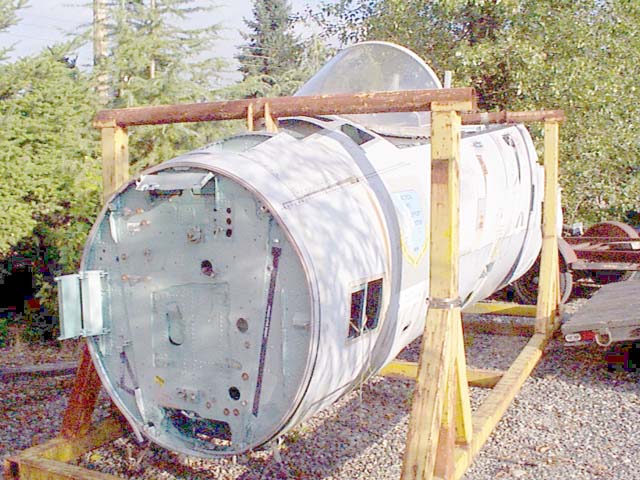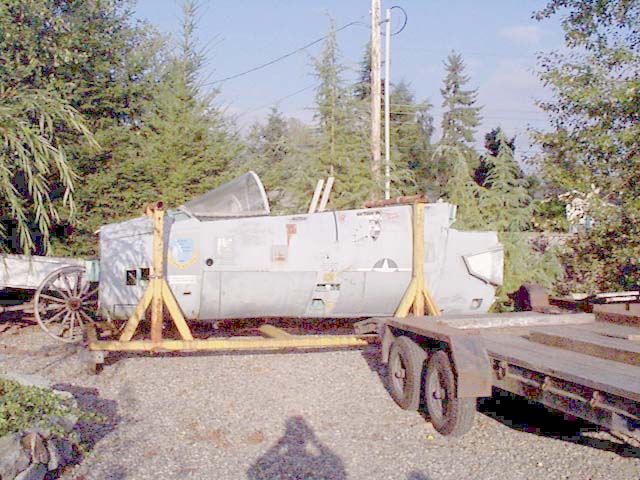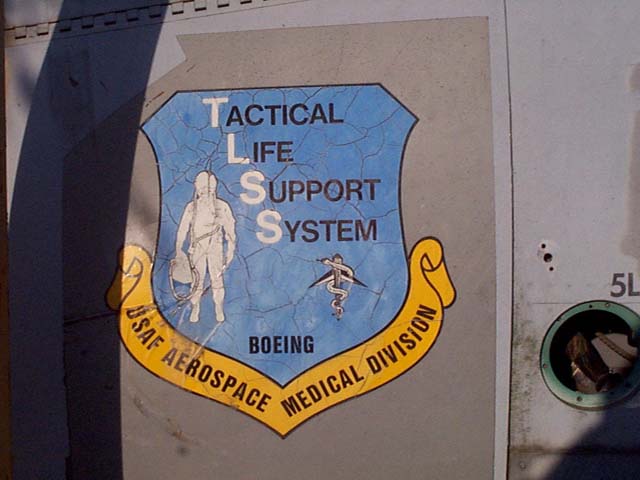
Initial Recovery

This is how the cockpit looked after it was transported to the owner's home from the Olympia Air Museum.
It's spent a great deal of its life outside in the elements and it shows. The fuselage's most recent use seems to have been as a training aid for Air Force maintenance personnel in repair battle damage. There are numerous areas where it looks like it took shotgun blasts at close range and then had skin repairs made.
This fuselage section is roughly 15 feet long and about 7 feet high as measured from the bottom of the fuselage to the top of the windscreen bow. Estimated weight is 1500 lbs.
The complete history of this section is still very much clouded in mystery. What I know about it is what little the previous owner knew, and what I can see on the cockpit itself. It was purchased from McChord AFB in Tacoma, WA during the period of time that McChord was host to an F-15 squadron. Due to the color Stars & Bars present on the aft section of the airframe, it's been suggested that the airplane was struck from the active inventory prior to 1986. I've been told that after 1986 the Air Force went to the monochrome colors for the Stars & Bars (and other) insignia on the F-15 and other aircraft.
This particular airframe was used in the Tactical Life Support System program during the mid 1980's.
It was also referred to as the Tactical Flight Support System. Initially it looked like I had one of their flying test
articles, but after further investigation we found that the airframe used at
Edwards AFB had not been struck. The search has now moved to the airbase that did the static testing for the TLSS/TFSS program.
There were four test articles used in the static tests at Brooks AFB and chances are very high that mine was one of those four.
I hope to know more soon.
I must thank both TSgt. Christopher Ball of Edwards AFB Public Affairs and Dr. Ray Puffer of the Edwards AFB Historical Research Division. Without the efforts of these two fine gentlemen, I never would have known where my airframe had come from.
The yellow support frame was installed by the people that converted it from an active duty aircraft. This will be replaced with a supporting cradle that will allow full access to all the avionics bays and other access points.
On to the rest of the images!

Here you can see where the radar assembly mounted to the nose. There is a 1/4" plate attached to what looks to be the first former in the airframe. The plate is going to be used to support the forward cradle pillar. This is being done to allow the two forward avionics bay hatches to be opened. As you can see here, the current stand totally blocks these from opening more than a few inches.
The large square piece of metal on the left edge of the nose is the radome hinge. This was connected to the "nose cone" of the aircraft and it allowed the crews easy access to the radar antenna and its tracking assembly. The black stripe is where the "stick" for holding the radome open was stored.
You'll notice that on the top of the fuselage ahead of the windscreen there are a couple of panels missing. These will have to be fabricated by hand and replaced. There is also a very poor sheet metal cover that's been applied to just above the right side avionics bay hinge. This will have to be removed and replaced with a section that is custom fit to that location. There is also a pair of holes in the avionics bay hatch itself that will have to be replaced. The open spaces closest to the windscreen are access plates to allow the bolts that hold the windscreen in place to be removed.
The square opening that's visible in the avionics bay cover once held the pitot probe assembly. There is a matching unit on the left side (facing the nose) avionics bay cover as well.

This logo is painted on both the left and right avionics bay hatches.
To the right of the logo is where the left Angle of Attack vane was located. The AOA vane is basically a a fin that freely rotates. It informs the flight data computer as to the angle the wing is at in relation to horizontal.
I was pointed to a very good F-15 research page. You can find it here .